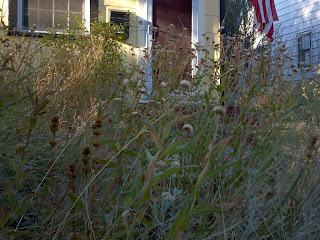Now is the time I think native plant garden shines- this is the reason we have selected locally appropriate species- a suite of plants designed to handle these situations- without any interference or assistance from us. Make no mistake- it is dry, and we have received only a fraction of normal moisture this summer (normal for August* is 1.23”, and probably going down). I never gave a thought to watering, and I’m not worried about the plants at all.
For a variety of reason, I’ve been digging some holes in the garden- to transplant some plants, dig post holes and remove some plants. In each case I was amazed by how little soil moisture there is. None. Yet the plants survive, and even thrive. Although many plants are dormant, even if prematurely for the year, not all are. The rubber rabbitbrush (Ericameria nauseosa) is just starting to flower, and some of the fleabanes (Erigeron species), are re-flowering; a sign of reverse photoperiodism.
Early dormancy is a common strategy for dealing with the unusual hot and dry conditions. It happens in the wild and in our garden- there is a nice harmony and symmetry with that. It helps me feel connected to the natural world. When I was elk hunting this weekend, the plants looked the same there as in my garden. And actually, many in my garden looked a bit more lush. In the woods right now even the serviceberry (Amalanchear alnifolia) have either lost their leaves or they have turned brown. All, save the plants in the riparian areas that will stay lush and green through the fall. We live in a water limited environment here.
I don’t really understand why people plant native plants- wanting the benefits of water conservation, but then water them like conventional plants, or expect them to look like they do in June all year long. That is not how it works, and not how these plants have adapted to our local ecosystems. Trying to change this aesthetic just reminds me as a group native plant and wildlife gardeners have only come so far. We need to accept the beauty in the natural world, and the values and aesthetics of something different than an emerald green lawn, and roses and annuals flowering in the end of August (when we have only received a millimeter of precipitation).
The garden is dry and beautiful and next spring it will be alive and well, and set up beautifully if we don’t have any more rain next summer. And the insects, and birds will be back and there will probably be more of them to enjoy the garden again.
The garden is dry and beautiful and next spring it will be alive and well, and set up beautifully if we don’t have any more rain next summer. And the insects, and birds will be back and there will probably be more of them to enjoy the garden again.
*weather data according to weather.com





0 comments:
Post a Comment